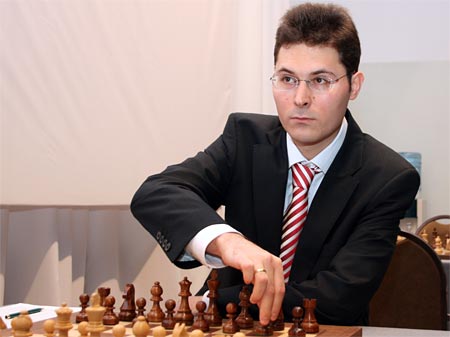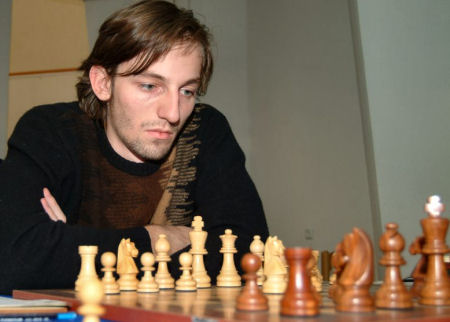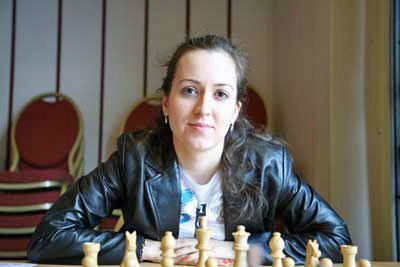| Latest | Greatest | Lobby | Journals | Search | Options | Help | Login |
|
|
|
This topic is archived. |
| Home » Discuss » Topic Forums » Sports |
|
| Jack Rabbit
|
Sat Jun-16-07 11:23 PM Original message |
| The Jack Rabbit Chess Report for June 17: Happy Father's Day |
|
Edited on Sat Jun-16-07 11:37 PM by Jack Rabbit
The Jack Rabbit Chess Report for the week ending June 17 Happy Fathers' Day  from the website of Seton Hall University Contents Post 1: http://www.democraticunderground.com/discuss/duboard.php?az=show_mesg&forum=215&topic_id=49836&mesg_id=49837">News for the week Post 2: http://www.democraticunderground.com/discuss/duboard.php?az=show_mesg&forum=215&topic_id=49836&mesg_id=49838">Diagrams and other features Post 3: http://www.democraticunderground.com/discuss/duboard.php?az=show_mesg&forum=215&topic_id=49836&mesg_id=49839">Games from Current and Recent Events |
| Printer Friendly | Permalink | | Top |
| Jack Rabbit
|
Sat Jun-16-07 11:25 PM Response to Original message |
| 1. News for the week ending June 17 |
|
Candidates Matches Conclude in Elista: Four bound for Mexico City
 Alexander Grischuk defeated fellow Russian grandmaster Sergey Rublevsky in a playoff of three rapid games in Elista, the capital of the autonomous Russian republic of Kalmykia, to become the fourth qualifier for the World Championship Tournament in Mexico City in September. Grischuk won the first and third games with Black while the second game was drawn to give Grischuk a 2½-½ victory and rendering a gourth scheduled rapid game moot. Three other players qualified for the Mexico City event in their respective regulation six-game matches: Levon Aronian of Armenia, Hungarian grandmaster Peter Leko and Israel's Boris Gelfand.  The Four Winners Flanking Kirsan Alexander Grischuk, Boris Gelfand, Fide President Kirsan Ilyumzhinov, Peter Leko and Levon Aronian Candidates' Matches Finals Elista, Kalmykia (Russia) Levon Aronian. . . .1 ½ ½ ½ ½ ½ -- - 3½ . . . . . . Peter Leko . . . . .1 ½ 1 ½ ½ - -- - 3½ Alexey Shirov. . . .0 ½ ½ ½ ½ ½ -- - 2½ . . . . . . Evgeny Bareev. . . .0 ½ 0 ½ ½ - -- - 1½ Alexander Grischuk .1 ½ ½ 0 ½ ½ 2½ - 5½ . . . . . . Gata Kamsky. . . . .½ ½ 0 ½ 0 - -- - 1½ Sergey Rublevsky . .0 ½ ½ 1 ½ ½ .½ - 3½ . . . . . . Boris Gelfand. . . .½ ½ 1 ½ 1 - -- - 3½ Each of the eight finalists qualified by winning semi-final matches held in Elista the week before. The four qualifiers will be joined in Mexico City by four seeded players: reigning world champion Vladimir Kramnik of Russia, Russian grandmasters Alexander Morozevich and Peter Svidler and the world's current top-ranked grandmaster, Vishy Anand of India. There is some talk of seeding former FIDE world champion Veselin Topalov of Bulgaria as a ninth player in Mexico City. Second Aerosvit International Tournament begins Monday in the Crimea  The second annual Aerosvit International Tournament begins tomorrow in the Crimean resort of Foros, Ukraine. This year's participants are: Ukrainian grandmasters Vassily Ivanchuk, Sergey Karjakin and Pavel Eljanov; Russians Peter Svidler, Dmitry Jakovenko and Sergey Rublevsky; Latvian native Alexey Shirov of Spain; Liviu-Dieter Nisipeanu of Romania; India's Krishnan Sasikiran; Dutch grandmaster Loek van Wely; Lenier Domínguez of Cuba; and former US national champion and Ukrainian native Alex Onischuk. Last year's event was won by Rublevsky. The 11-round tournament will conclude June 29. Dutch National Championships start in Hilversum  The Dutch national championships, one of the strongest national championships outside the former Soviet Union, began yesterday in Hilversum, Holland, with the first round of the men's event. The Women's championship begins tomorrow. The men's competion will consist of defending champion Sergei Tiviakov, a native Russian, Ivan Sokolov, who was born in Bosnia, Erwin L'Ami, Friso Nijboer, Daniel Stellwagen, Jan Smeets, Ruud Janssen, John van der Wiel, Martijn Dambacher, Wouter Spoelman, Manuel Bosboom and Willy Hendriks. For the first time in many years, Loek van Wely, who won the event seven times, will not be participating. Mh. van Wely will be competing in the Areosvit International in Foros, Ukraine. In first round action for the men yesterday, Sokolov defeated Bosboom, L'Ami won his game with Spoelman, Smeets vanquished Hendricks and Nijboer bested Janssen. Dambacher-van der Wiel and Stellwagen-Tiviakov both ended in draws. The women's event will include Chinese-born Peng Zhoaqin, who has won the event seven years in a row, Bianca Muhren, Desiree Hamelink, Pauline van Nies, Arlette van Weersel, Colleen Otten, Martine Middelveld, the Bensdrop twins, Marlies and Laura, and Belgain player Donna Schut Both competitions conclude June 28. Sparkassen Chess Meeting opens Saturday in Dortmund  The annual Sparkassen Chess Meeting, one of the "big three" events in chess, begins this saturday in Dortmund, Germany. This year's event is a category 20 among eight players: world champion Vladimir Kramnik of Russia; the world's top-ranked grandmaster, Vishy Anand of India; Peter Leko of Hungary and Boris Gelfand of Israel, fresh from their triumphs in the Elista candidates' matches; Shakhriyar Mamedyarov of Azerbaijan; 16-year-old Norwegian grandmaster Magnus Carlsen; the reigning Russian national champion Evgeny Alekseev; and the reigning German champion, Arkadij Naiditsch. The Sparkassen is a seven-round tournament that concludes July 1. Last year's event was won by Kramnik in a tie-break over fellow Russian grandmaster Peter Svidler. Karpov taking part in Valjevo  Chessdom Former world champion Anatoly Karpov, 56, is making his first appearence in a classical event in four years this week in the Gorenje Tournament in Valjevo, Serbia. After four Rounds, Karpov is tied for first place with Turkish grandmaster Saut Atalik, Serbian Ivan Ivanisevic and Michael Roiz of Israel are leading with 2½ points each. Karpov moved into the tie yesterday when he defeated Kiril Georgiev for his first victory of the event against three draws. The event is scheduled for 9 rounds. Good luck, Tolya! |
| Printer Friendly | Permalink | | Top |
| Jack Rabbit
|
Sat Jun-16-07 11:26 PM Response to Original message |
| 2. Diagrams and other features on the JR Chess Report |
|
!""""""""# $tMvWlVmT% $OoOoOoOo% $ + + + +% $+ + + + % $ + + + +% $+ + + + % $pPpPpPpP% $RnBqKbNr% /(((((((() White to move This position is a theoretical draw Does this picture make sense to you? If not, or if it looks like a bunch of Wingdings, please click here. Diagrams used in the Jack Rabbit Chess Report are made with Chess Merida, a true type font that is available as freeware at the above link. Also, the JR chess report makes the main variation in annotations more distinct and readable by putting it in red. A secondary variation, is in blue and other colors are used if needed. |
| Printer Friendly | Permalink | | Top |
| Jack Rabbit
|
Sat Jun-16-07 11:28 PM Response to Original message |
| 3. Games from Current and Recent Events |
| Printer Friendly | Permalink | | Top |
| Jack Rabbit
|
Sat Jun-16-07 11:28 PM Response to Reply #3 |
| 4. Aronian - Shirov, Fianls, Round 1, Elista |
 Levon Aronian Levon Aronian vs. Alexey Shirov Candidates' Final Match, Round 1 Elista, June 2007 Open Queen's Gambit: Saduleto Opening (MacDonnell Defense) 1. d4 d5 2. c4 dxc4 3. e4
Black: Alexey Shirov !""""""""# $ T + +l+% $O O + Oo% $q+m+o+ +% $+ +w+ + % $ + O + +% $Bp+ + P % $p+ V P P% $R + +rK % /(((((((() White: Levon Aronian Position after 18. -- Qd7d5 19. Qc4!
Black: Alexey Shirov !""""""""# $ + T +l+% $Or+ + Oo% $ +o+o+ +% $+ P + + % $ + +m+ +% $+ +o+ P % $o+ + P P% $+ +r+ K % /(((((((() White: Levon Aronian Position after 26. -- Nd2e4 27. f3!
Black: Alexey Shirov !""""""""# $ + T +l+% $O + + Oo% $ +o+ + +% $+ P O + % $ + + + +% $+ +o+pP % $ + RmK P% $+r+ + + % /(((((((() White: Levon Aronian Position after 31. -- e6e5 32. Ra1
|
| Printer Friendly | Permalink | | Top |
| Jack Rabbit
|
Sat Jun-16-07 11:30 PM Response to Reply #3 |
| 5. Leko - Bareev, Fianls, Round 3, Elista |
|
Edited on Sat Jun-16-07 11:46 PM by Jack Rabbit
For affectionados of the Mikhail Tal school of chess, the games of Hungarian grandmaster Peter Leko are not a natural taste. He eschews flashy combinations in favor of the boa constrictor method of play, slowly squeezing the life out of his opponent by stopping any possibility of counterplay before it gets started, then slowly squeezing the life out of his opponent's position. Tal and his latter-day followers are like the swashbuckling hero played by Errol Flynn, setting up his opponent with swordplay and then dispatching his with a final flurry of sudden, swift strokes. Leko, in the mode of the late Tigran Petrosian, is more the sadistic villain played by Claude Rains,who enjoys sitting back and watching as his victim slowly suffers his doom.
Yet it is a pleasure, although for some of us a guilty one, to watch Leko's deft handling of pawns and minor pieces as he cuts the line from his opponent's pieces and the territory they once controlled or chase away intruding pieces with pawn moves in a way that resembles a horse waving off pesky flies. The game that follows is a fine example of Leko's best efforts. One thing to add is that Leko's personal temperament bears little resemblance to that of a Hollywood villain played by Claude Rains or Sidney Greenstreet. He is one of the most decent men among grandmaters.  Peter Leko Peter Leko vs. Evgeny Bareev Candidates' Final Match, Round 3 Elista, June 2007 Open German Game: Karpov Defense 1. e4 c6 2. d4 d5 3. Nc3 dxe4 4. Nxe4 Nd7 5. Ng5 Ngf6 6. Bd3
Black: Evgeny Bareev !""""""""# $ + +t+lT% $OvW +oO % $ O Vo+ O% $+ O + + % $ +pP + +% $+ +b+n+q% $pP B pPp% $R + R + % /(((((((() White: Peter Leko Position after 17. -- c6c5 18. d5!
Black: Evgeny Bareev !""""""""# $ + +t+lT% $OvW +o+ % $ O Vo+oO% $+ OpO + % $ +p+ + +% $+ Bb+ + % $pP + PpP% $R + R K % /(((((((() White: Peter Leko Position after 19. -- g7g6 20. Qh4!
Black: Evgeny Bareev !""""""""# $ + W + T% $O + ToL % $ O V M O% $+ OpO + % $b+p+ +v+% $+ B + + % $pP N Pp+% $R +qR K % /(((((((() White: Peter Leko Position after 29. -- Bc8g4:p 29. f3!
|
| Printer Friendly | Permalink | | Top |
| Jack Rabbit
|
Sat Jun-16-07 11:31 PM Response to Reply #3 |
| 6. Kamsky - Gelfand, Fianls, Round 3, Elista |
 Boris Gelfand Gata Kamsky vs. Boris Gelfand Candidates' Final Match, Round 3 Elista, June 2007 Queen's Pawn Game: London Opening 1. d4 Nf6 2. Nf3 d5 3. Bf4 c5 4. e3 Nc6 5. Bb5!?
Black: Boris Gelfand !""""""""# $ +t+ Tl+% $+ + +o+o% $ On+o+ +% $+ +o+ O % $ P P + +% $P + B +p% $ + +nPp+% $R +r+bK % /(((((((() White: Gata Kamsky Position after 21. Bf4e3 21. -- Nd6!
Black: Boris Gelfand !""""""""# $t+ + Tl+% $+ + + +o% $ O Mo+ +% $+p+o+ O % $pVmP O +% $+n+b+ +p% $r+ + Pp+% $+ Br+k+ % /(((((((() White: Gata Kamsky Position after 30. Kg1f1 30. -- Nxb5!
Black: Boris Gelfand !""""""""# $ + + +k+% $+ + +t+o% $ O +o+ +% $+m+o+ O % $ + P O +% $+t+n+ +p% $r+ K Pp+% $R + + + % /(((((((() White: Gata Kamsky Position after 40. Ke2d2 40. -- Nxd4
|
| Printer Friendly | Permalink | | Top |
| Jack Rabbit
|
Sat Jun-16-07 11:33 PM Response to Reply #3 |
| 7. Rublevsky - Grischuk, Final Match Playoff, Game 1, Elista |
|
It is a delight to an anti-establishment rebel to see Alexander Grischuk advance to the world championship tournament in Mexico City. He was the one qualifier to emerge in Elista to come to the closing banquet spouting a jacket and an open collar. It appears he last shaved about three days ago. Earlier this year, he referred to FIDE new world championship format as "hilarious" and "ridiculous."
Will, just as somebody has to tell Mr. Bush that his signature war is lost, somebody needs to tell FIDE President Kirsan Ilyumzhinov that the old world championship cycle wasn't broken until he tried to fix it. It won't do any good, though. Bush thinks he talks to God and Kirsan thinks he gets free rides from space aliens.  Alexander Grischuk Sergey Rublevsky vs. Alexander Grischuk Candidates' Final Match Playoff, Rapid Phase, Game 1 Elista, June 2007 Open Royal Game: Classical Defense (Scotch Opening) 1. e4 e5 2. Nf3 Nc6 3. d4 exd4 4. Nxd4 Bc5 5. Nxc6
Black: Alexander Grischuk !""""""""# $ T T +l+% $+ O +oO % $ +o+q+ M% $+ QoPv+o% $o+ + P P% $+ +bB + % $pPp+ +p+% $+kR + +r% /(((((((() White: Sergey Rublevsky Position after 22. Re1c1 22. -- Bxd3!
Black: Alexander Grischuk !""""""""# $ T + +l+% $+ O + O % $ + +o+ +% $+ +oPm+o% $o+ + P P% $+ +p+ + % $pT + Bp+% $Kr+ + +r% /(((((((() White: Sergey Rublevsky Position after 28. Rc1b1 28. -- a3!!
|
| Printer Friendly | Permalink | | Top |
| Jack Rabbit
|
Sat Jun-16-07 11:34 PM Response to Reply #3 |
| 8. Bryant - Nakamura, Round 1, National Open, Las Vegas |
 Hikaru Nakamura To view this game:
John Bryant vs. Hikaru Nakamura National Open, Round 1 Las Vegas, June 2007 Sicilian Game: Saragossa Opening (Alapin Variation) 1. e4 c5 2. c3 Nf6 3. e5 Nd5 4. Nf3 Nc6 5. d4 cxd4 6. cxd4 d6 7. Bc4 Nb6
Black: Hukaru Nakamura !""""""""# $ +t+ Tl+% $Oo+ WoOo% $ +m+o+ +% $+b+o+ + % $ +m+ + +% $+nN + +p% $pP +qPp+% $R + +rK % /(((((((() White: John Bryant Position after 16. Qd1e2 16. -- Nb4!
Black: Hikaru Nakamura !""""""""# $ +t+ Tl+% $Oo+ WoOo% $ + +o+ +% $+ N Pv+ % $ +oP + +% $+ N + +p% $pPm+qPp+% $+ +r+rK % /(((((((() White: John Bryant Position after 19. Ra1d1 19. -- Nxd4!!
Black: Hikaru Nakamura !""""""""# $ +tT +l+% $O + +oOo% $ + +o+ +% $+ W P + % $ OoRqP +% $+ + + +p% $pP + +p+% $+ +r+ K % /(((((((() White: John Bryant Position after 27. Rd1d4:Q 27. -- c3!
|
| Printer Friendly | Permalink | | Top |
| Jack Rabbit
|
Sat Jun-16-07 11:35 PM Response to Reply #3 |
| 9. Krush - Shabalov, Round 5, National Open, Las Vegas |
|
Irina Krush, America's first lady of chess, won in fine effort against newly crowned US national champion Alex Shabalov.
 Irina Krush To view this game:
Irina Krush vs. Alex Shabalov National Open, Round 5 Las Vegas, June 2007 Open Semi-Slav Queen's Gambit: Hastings Opening (Botvinnik Defense) (Anti-Meran Gambit) 1. d4 d5 2. c4 c6 3. Nc3 Nf6 4. Nf3 e6 5. Bg5 dxc4 6. e4 b5 7. e5 h6 8. Bh4
Black: Alex Shabalov !""""""""# $ + TlV T% $O +m+o+ % $v+p+op +% $W + + B % $ PpPn+ +% $+ + +qP % $pP + P P% $R + Kb+r% /(((((((() White: Irina Krush Position after 14. Qd1f3 14. -- Rd8?!
Black: Alex Shabalov !""""""""# $ + +lV T% $O + +o+ % $wMo+o+ +% $+ +t+ + % $ +oP + +% $+o+ BqP % $pP +bP P% $R + K +r% /(((((((() White: Irina Krush Position after 18. -- b4b3 19. 0-0!
|
| Printer Friendly | Permalink | | Top |
| DU
AdBot (1000+ posts) |
Fri Apr 26th 2024, 01:54 PM Response to Original message |
| Advertisements [?] |
| Top |
| Home » Discuss » Topic Forums » Sports |
|
Powered by DCForum+ Version 1.1 Copyright 1997-2002 DCScripts.com
Software has been extensively modified by the DU administrators
Important Notices: By participating on this discussion board, visitors agree to abide by the rules outlined on our Rules page. Messages posted on the Democratic Underground Discussion Forums are the opinions of the individuals who post them, and do not necessarily represent the opinions of Democratic Underground, LLC.
Home | Discussion Forums | Journals | Store | Donate
About DU | Contact Us | Privacy Policy
Got a message for Democratic Underground? Click here to send us a message.
© 2001 - 2011 Democratic Underground, LLC